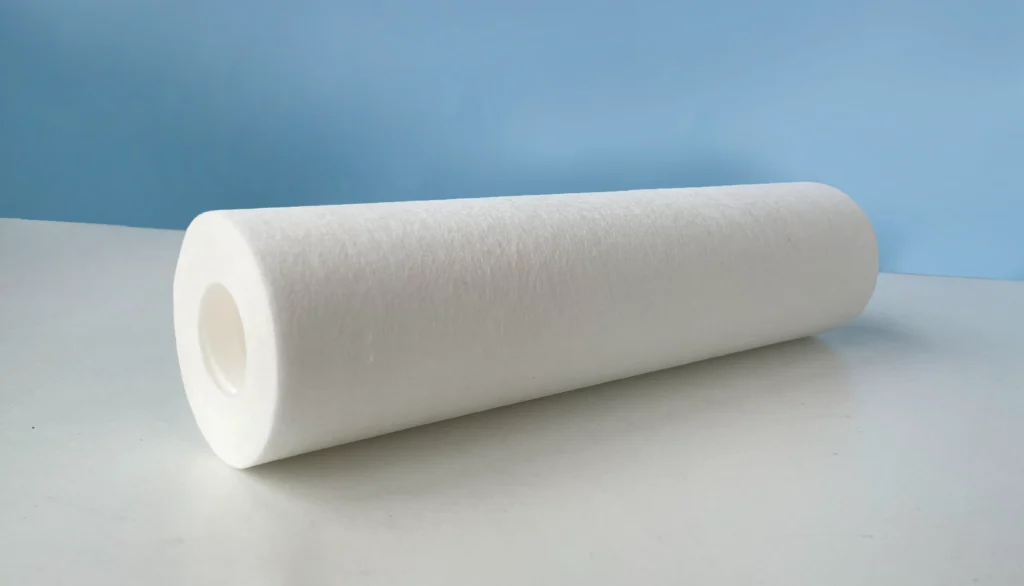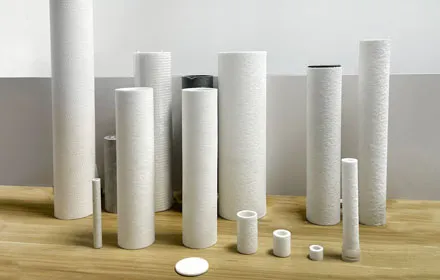Water purifiers are categorized by their filtration accuracy into four main types: microfiltration, ultrafiltration, nanofiltration, and reverse osmosis.
While these types of filters are all considered water purification devices, their principles, materials, effects, and usage scenarios differ significantly. However, in all four types of water purifiers, PP cotton filter cartridge is almost always used as the first-stage filter element.
What is a PP Cotton Filter Cartridge?

PP cotton filter cartridges are tubular filter elements made from non-toxic and odorless polypropylene particles through a process of heating, melting, spinning, drawing, and forming. If the primary raw material is polypropylene, it is called a PP melt-blown filter element.
Key Advantages of PP Cotton as a First-Stage Filter
1. Removing Particulate Impurities from Water
Water flows from the outside of a PP cotton filter cartridge to the inside, passing through multiple layers of filtration. The closer to the inner layer of the filter element, the smaller the pore size, the higher the filtration accuracy.
When particulate impurities pass through the pores of a PP cotton filter cartridge, they form bridges, intercepting even particles smaller than the pores, thus removing all particulate impurities from the filtered liquid.
2. Multi-layer, deep-dense structure for exceptionally high dirt holding capacity
The outer fibers of the PP cotton filter cartridge are coarser, while the inner fibers are finer. The outer layer is relatively loose, while the inner layer is dense, creating a gradually increasing density.
Each layer of this multi-layer structure intercepts and stores impurities in the water. The combined effect of these layers results in a significant dirt holding capacity.
3. High filtration flow rate, low pressure differential
The polypropylene fibers used in PP cotton are self-adhesive and intertwined, forming a 3D, tortuous microporous structure.
Unlike the fiber distribution in traditional fabrics and carded nonwovens, PP cotton has a larger surface area and higher porosity.
This large surface area and numerous pores allow water to flow quickly through the PP cotton, minimizing the difference in water level between the inner and outer layers. This results in a high filtration flow rate and a low pressure differential.
4. No chemical adhesives, more hygienic and safer
Polypropylene is melt-blown and drawn, allowing the polypropylene fibers to self-adhere and entangle, creating PP cotton filter cartridges of varying shapes and sizes.
Unlike other filter elements, PP cotton filter cartridges do not require bonding with other materials.
Because PP cotton’s chemical composition is clean and meets food hygiene standards, it will not cause secondary contamination to the liquid being filtered, making it safer to use.
5. Resistant to acids, alkalis, organic solvents, and oils
The chemical stability of PP cotton is closely related to its raw material, polypropylene.
Polypropylene has excellent chemical stability. While it can be corroded by concentrated sulfuric acid and concentrated nitric acid, it is relatively stable to various other chemicals.
Contact us today at www.maifilter.com to request a quote or learn more about our full range of water filter cartridges.
How Long Does a PP Filter Cartridge Last?
Because PP cotton filter cartridges are the first-stage filter element, their lifespan is relatively short, generally requiring replacement every three to six months. To prevent secondary contamination of your home water purifier, remember to replace them regularly.
Regular replacement is essential to maintain filtration efficiency and prevent secondary contamination in your water purifier.
While PP cotton’s role is significant, it can only serve as the first stage of filtration in a water purifier. Deeper filtration requires more sophisticated filter elements, such as activated carbon fiber cartridge or RO reverse osmosis filters.
How can you determine the quality of a PP filter element?
You can judge by weight, compressibility, material, and colloid content.
Weight: Check the weight by hand. The heavier the weight, the higher the fiber density, which generally indicates better quality.
Compressibility: Check the PP cotton filter cartridge’s strength by hand. The stronger it is, the better the quality. Generally speaking, higher fiber density means better compressibility.
Material: Check the color and surface of the filter paper. Generally, genuine filter paper will have a uniform color and a smooth texture. Glue: Check the elasticity of the PP cotton filter cartridge. Good elasticity generally indicates good quality

